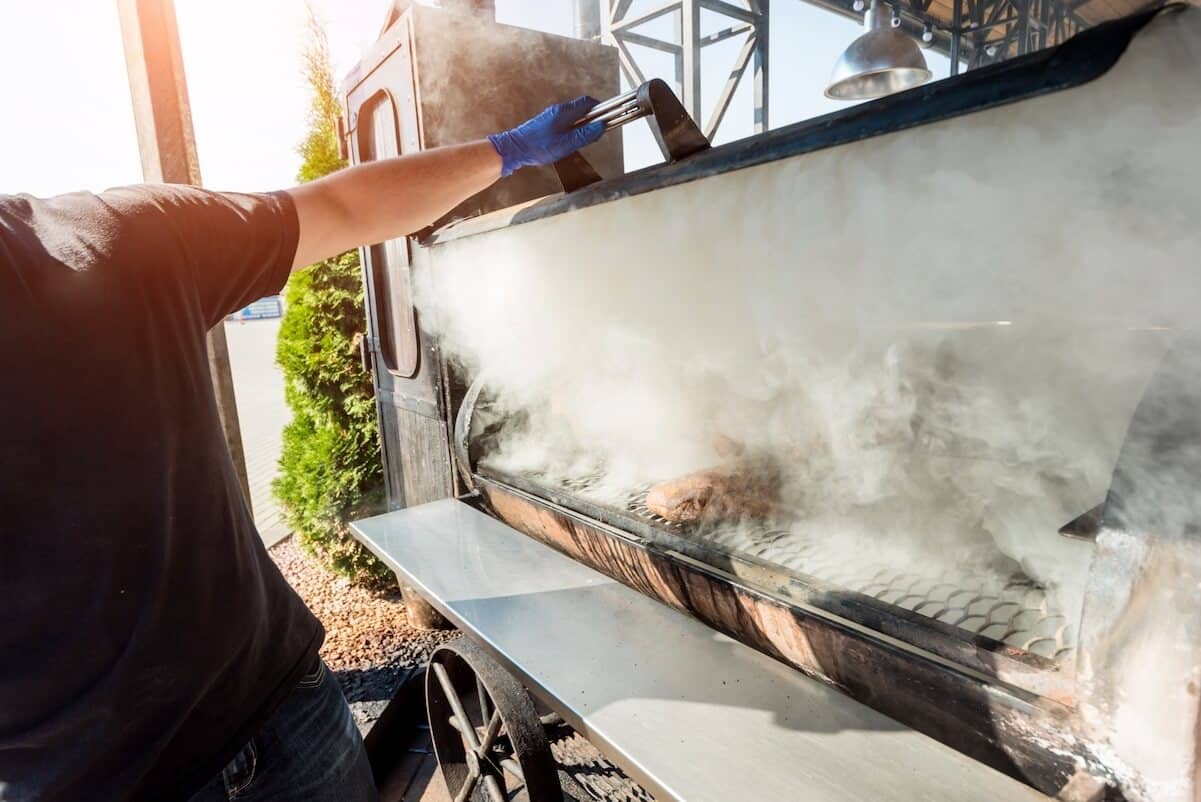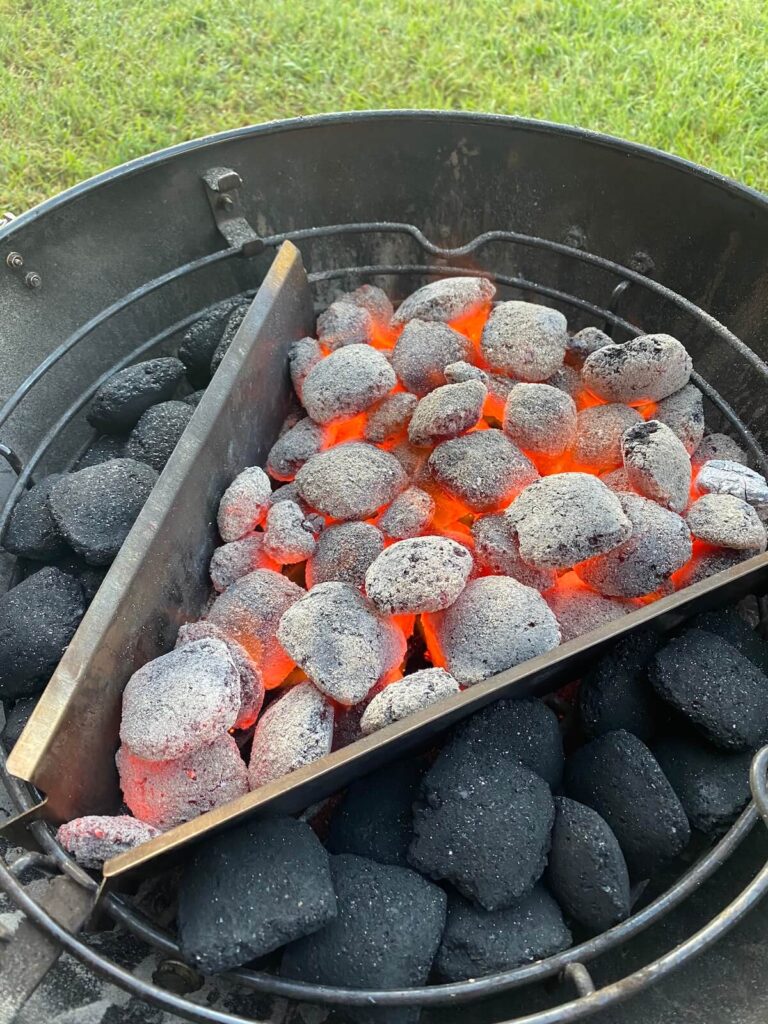This guide to the best wood for smoking food is for you if you’re ready to take your backyard barbecue from pedestrian to pitmaster. Smoking meat is an art, and like any art, it requires the right tools and knowledge. Wood selection is one of the most critical factors when it comes to smoking. Different woods impart distinct flavours to your food, so understanding which wood to use when is essential and this doesn’t just go for smoked meat either!
This guide will help you choose the perfect wood for your food and give you a little more background on the difference and flavour profiles of each of the more popular smoking woods.
And to make your life even easier, we’ve got a wood smoking chart that you can print off for quick reference in future too!
The Best Wood For Smoking Food
When it comes to smoking food, choosing the right wood is crucial. The type of wood you use can significantly influence the flavour, aroma, and overall taste of your smoked dishes.
Here are some of the most popular types of wood for smoking meat and other food as well as a few less common ones in case you’re keen to experiment with new flavours beyond the norm too:
Citrus Wood
Citrus woods such as lemon and orange provide a refreshing, subtle citrusy flavour. They burn at a moderate temperature, making them ideal for delicate meats and vegetables.
- Flavor Profile: Light, fruity, and slightly tangy.
- Best For: Chicken, Seafood, Vegetables
Apple Wood
The most popular fruit wood, apple offers a light, fruity sweetness that complements delicate flavours. Apple wood produces a gentle sweetness that complements a variety of foods. It’s great for longer smoking sessions and adds a light, fruity aroma.
- Flavour Profile: Sweet, mild, and fruity.
- Best For: Chicken, Pork, Vegetables, Cheese
Cherry Wood
Similar to apple, cherry smoke has a slightly tart sweetness that pairs well with poultry, pork, and even some vegetables. Cherry wood gives a beautiful mahogany colour to your meat while imparting a mild, sweet smoke. It’s versatile and a good wood to have on hand.
- Flavour Profile: Sweet, mild-to-medium, with a hint of fruitiness.
- Best For: Chicken, Pork, Beef, Game
Hickory Wood
A legend in the smoking world, hickory delivers a bold punch. Hickory wood provides a robust smoke that’s a favourite for classic BBQ. This wood is a classic choice for red meat, offering a strong, smoky, bacon-like flavour.
- Flavour Profile: Strong, smoky, and slightly sweet.
- Best For: Pork, Beef, Game
Pear Wood
Similar to apple and cherry, pear wood offers a unique sweetness that’s less overpowering, making it perfect for poultry and cheese
- Flavour Profile: Subtly sweet and fruity.
- Best For: Chicken, Pork, Cheese
Peach Wood
Peach wood adds a gentle fruity flavour without overwhelming the meat. It’s excellent for a variety of BBQ dishes.
- Flavour Profile: Delicate, sweet, and slightly tangy.
- Best For: Chicken, Pork, Beef
Apricot Wood
Apricot wood delivers a nuanced, sweet smoke that enhances the natural flavours of meat, particularly poultry and lamb.
- Flavour Profile: Sweet and fruity, stronger than peach.
- Best For: Chicken, Pork, Lamb
Alder Wood
Alder wood burns at a lower temperature, making it ideal for delicate foods like fish and vegetables, adding a light smokiness without overpowering them.
- Flavour Profile: Light, sweet, and slightly smoky.
- Best For: Seafood, Chicken, Vegetables
Plum Wood
Plum wood offers a subtle, complex flavour that enhances meats like pork and lamb without masking their natural taste.
- Flavour Profile: Mild, sweet, and fruity.
- Best For: Pork, Lamb, Game
Maple Wood
Maple wood imparts a mellow sweetness, making it a versatile choice for various smoked dishes.
- Flavour Profile: Mild, sweet, and light.
- Best For: Pork, Chicken, Cheese, Vegetables
Oak Wood
Oak offers a versatile, medium-bodied smoke that goes well with most meats. It’s a great choice for beginners who are still experimenting with different flavours. There are two common types of oak used for smoking, red oak with a slightly stronger flavour and white oak, with a more mild all-purpose flavour.
Oak wood burns cleanly and evenly, providing a strong but not overpowering smoky flavour. It’s reliable for long smoking sessions.
- Flavour Profile: Medium-to-strong and robust.
- Best For: Beef, Lamb, Pork, Game
Pecan Wood
Pecan wood is similar to hickory but milder. Its rich, nutty flavour pairs well with a variety of meats, adding depth without being too intense.
- Flavour Profile: Rich, nutty, and slightly sweet.
- Best For: Pork, Beef, Poultry
Mulberry Wood
Mulberry wood is great for adding a light, fruity flavour to your smoked dishes, enhancing the natural taste of the meat.
- Flavour Profile: Sweet and tangy, similar to apple wood.
- Best For: Pork, Chicken, Vegetables
Whisky Barrel Wood
Flavour Profile: Robust and smoky with hints of caramel and whisky.
Best For: Beef, Pork, Game Description: Made from aged whisky barrels, this wood adds a unique depth and complexity to smoked dishes, perfect for hearty meats.
Walnut Wood
Walnut wood delivers a potent smoke. It’s best used in moderation or mixed with milder woods to balance its intensity.
- Flavour Profile: Strong and slightly bitter.
- Best For: Beef, Game
Mesquite Wood
This bold wood is for the adventurous smoker. Mesquite delivers a powerful, smoky taste that can overpower some meats. Use it sparingly with strong-flavoured options like brisket or ribs. Mesquite wood burns hot and fast, providing a powerful, earthy smoke. Ideal for quick smokes and robust meats.
- Flavour Profile: Very strong, earthy, and intense.
- Best For: Beef, Game
Food Pairing Guide: Best Woods for Different Foods
So we’ve talked about the different woods and covered what they are good for, but sometimes you just want a quick reference for what wood is right for what food. Here is the best wood for smoking meat, vegetables, bread and cheese:
Chicken
Chicken benefits from lighter, sweeter woods that add a delicate flavour without overpowering the meat.
- Best Woods: Apple, Cherry, Citrus, Pear, Peach, Apricot, Maple, Alder
Beef
Beef can handle stronger, bolder woods that enhance its rich flavour and stand up to long smoking sessions.
- Best Woods: Oak, Mesquite, Hickory, Whisky Barrel, Cherry, Peach, Pecan
Pork
Pork pairs well with sweet, fruity, and nutty woods that complement its natural sweetness and fat content.
- Best Woods: Apple, Cherry, Maple, Pecan, Peach, Plum, Hickory, Apricot, Mulberry
Lamb
Lamb’s robust flavour works well with both fruity and strong, smoky woods that add depth without masking its taste.
- Best Woods: Oak, Plum, Apricot, Cherry, Mesquite, Pecan
Seafood
Seafood is delicate and requires lighter, milder woods that enhance rather than overpower its natural flavours.
- Best Woods: Alder, Citrus, Apple, Cherry
Bread
Baking bread in a smoker adds a unique flavour profile, just like cooking bread over the campfire, where it’s pretty hard to beat that smokey campfire taste. These woods impart a mild, sweet, and slightly nutty essence.
- Best Woods: Maple, Oak, Pecan, Alder
Vegetables
Vegetables benefit from lighter, sweet woods that enhance their natural flavours without being too intense.
- Best Woods: Maple, Citrus, Alder, Apple, Mulberry
Game Meat
Game meats, like deer, wild boar, elk, rabbit and kangaroo have strong flavours that are complemented by bold, robust woods that add complexity to the dish.
- Best Woods: Hickory, Oak, Mesquite, Cherry, Plum, Whisky Barrel
Cheese
Cheese requires a gentle smoke that enhances its creamy texture and adds a subtle flavouring without being too overpowering.
- Best Woods: Apple, Cherry, Maple, Alder, Pear
Pro Tips for Smoking Food

- Wood prep: Use dry, untreated wood chunks or chips. Avoid using wet or mouldy wood, as it can impart bitter flavours.
- Soak or not to soak? Soaking wood chips for 30 minutes can produce more smoke, but it’s not mandatory.
- Start low and slow: Smoking is a low-and-slow cooking method. Aim for temperatures between 225-275°F (105-135°C).
Free Printable Wood Smoking Chart
To help you on your smoky journey, I’ve included a free downloadable cheat sheet that summarizes the key points from this guide. It includes a list of common smoking woods and recommendations for pairing them with different meats.
Smoking food is a rewarding experience that allows you to add delicious smoky flavours to your favourite dishes. With a little knowledge and experimentation, you’ll be smoking like a pro in no time.
Do you have a favourite smoking wood? Tell us in the comments.


